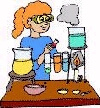down 2.
____ take place in plants during the food-making process (photosynthesis) by which plants use light, water, and carbon dioxide and release oxygen. (2 words)
|
down 3.
The ability of a substance to be a part of a chemical change.
|
down 5.
The change in which no new kinds of matter are formed, but in which the size, shape, or state of the matter may change. (2 words)
|
down 7.
As a result of the law of conservation, during a chemical change the mass of the products is equal to the mass of the ____.
|
down 11.
If matter has changed but you can change the matter back to its ____ form, then the change that took place was a physical change.
|
across 1.
A change in which new or different kinds of matter are formed. (2 words)
|
across 4.
The law of ____ of energy states that energy can never be destroyed or created.
|
across 6.
The ability of a substance to be burned.
|
across 8.
The rusting of metal is an example of a ____ change.
|
across 9.
After a physical or chemical change, the total amount of matter is the ____ as it was before.
|
across 10.
The melting of an ice cube is an example of a ____ change.
|
across 12.
When ____ takes place in an animal many chemical changes occur.
|
across 13.
When a candle is lit, it undergoes a chemical change and as a result it releases both light and ____.
|
across 14.
If a change releases this, it is more than likely a chemical change.
|


























































































































































































































































































































































































































































































































































































































































































